Menu
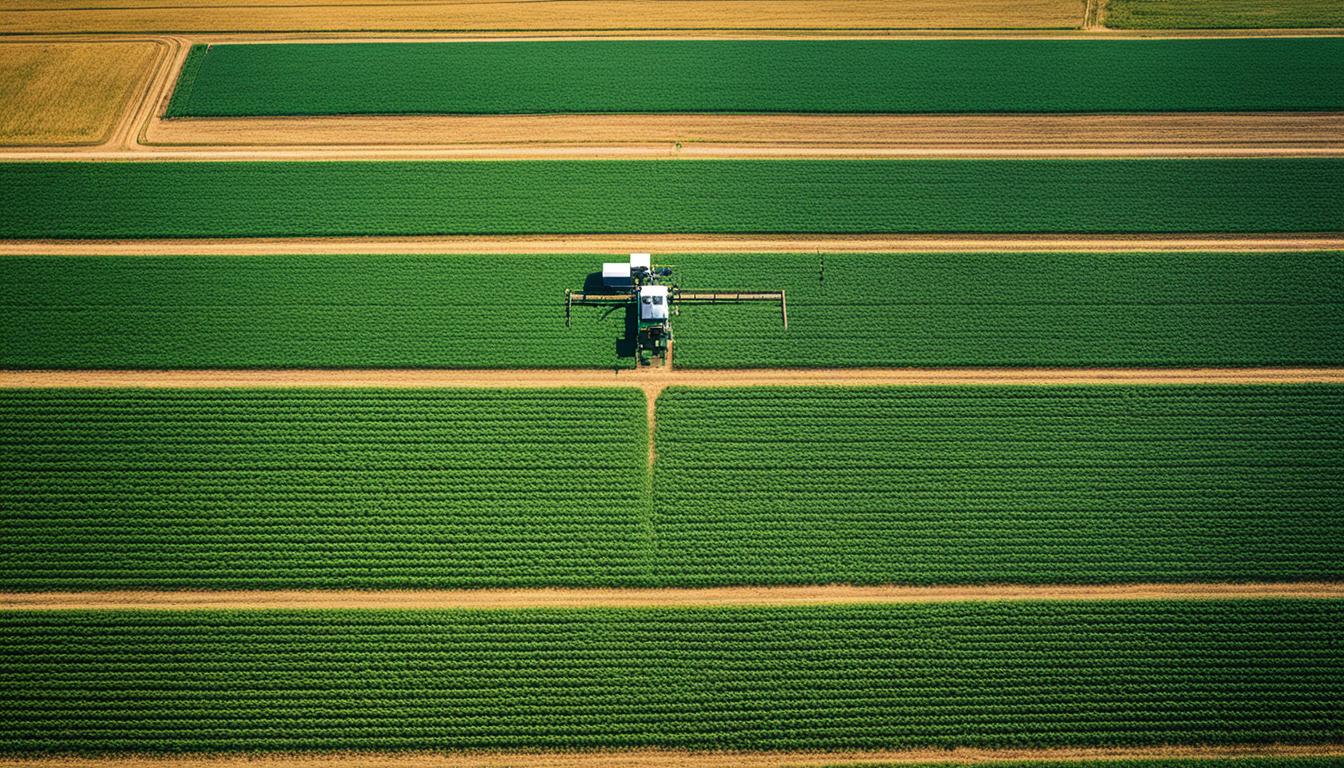
Only about 15% of tractors have GPS, which means a lot of farm equipment is exposed to theft. GPS in farming isn’t just for safety. It’s changing how farms work by giving exact data for everything from field maps to spotting trouble spots. As high-tech tools become more common, farmers of any size can enjoy these benefits.
Agricultural GPS makes farming smarter and more efficient. It helps accurately map fields, track crops, and precisely apply chemicals. This leads to savings, higher crop yields, and farming that’s better for the environment. In America, firms like Verizon Connect offer tracking systems that make farms more efficient. They watch over machine time, idle times, and show where vehicles go, helping farmers use their assets better.
GPS farm equipment tracking has changed the game in agriculture. With tech getting better, so does the ability to handle farm machinery. This leads to more efficiency, more productivity, and better security.
Precision agriculture got a big boost from GPS. Farmers can now work on land variations better, which means smarter treatment for soil and plants. There were over 10,000 cases of farm equipment theft in 2016. This shows why security measures like GPS are so vital.
Since 1948, the US has seen farm output more than double, even though less land and workers are needed. This was mainly thanks to new tech, like GPS. It shows that farms of all sizes can benefit from GPS farm equipment tracking, not just big ones.
GPS farm equipment tracking works by using satellites to pinpoint the locations of machines. There are GPS receivers on the equipment. These talk to satellites to give up-to-the-minute location data. This makes moving and working on farms much easier.
One big plus is that it helps stop theft. If someone steals a machine, it can be found and recovered fast. It also saves farmers time and money on planting by making the process more efficient. It helps with precise farming tasks, such as mapping fields and irrigation.
Companies like Verizon Connect are making this tech even better. They provide tracking for the whole fleet, which means running a farm is cheaper and more efficient. It gives farmers peace of mind, knowing where their valuable equipment is at all times.
Today’s GPS devices remind farmers about servicing their machines, which keeps everything running smoothly. They also keep track of costs and usage, helping with budgets and planning. All this data supports making smart decisions on the farm.
Modernising GPS tech keeps making farming better and more productive. With fleet tracking, farmers can fully use these benefits, making it essential in today’s agriculture.
| Benefit | Explanation |
|---|---|
| Enhanced Productivity | Precision application of chemicals and efficient management of field activities. |
| Cost Reduction | Reduced trips and better resource allocation, saving fuel and labour costs. |
| Theft Prevention | Real-time tracking and geofencing enhance security and recovery rates. |
| Maintenance Management | Scheduling based on engine hours ensures timely servicing of equipment. |
| Data-Driven Decisions | Comprehensive reports on equipment use and field productivity guide strategic planning. |
GPS and precision agriculture tools have changed farming for the better. Now, farmers can see more crops, protect the environment, and save money.
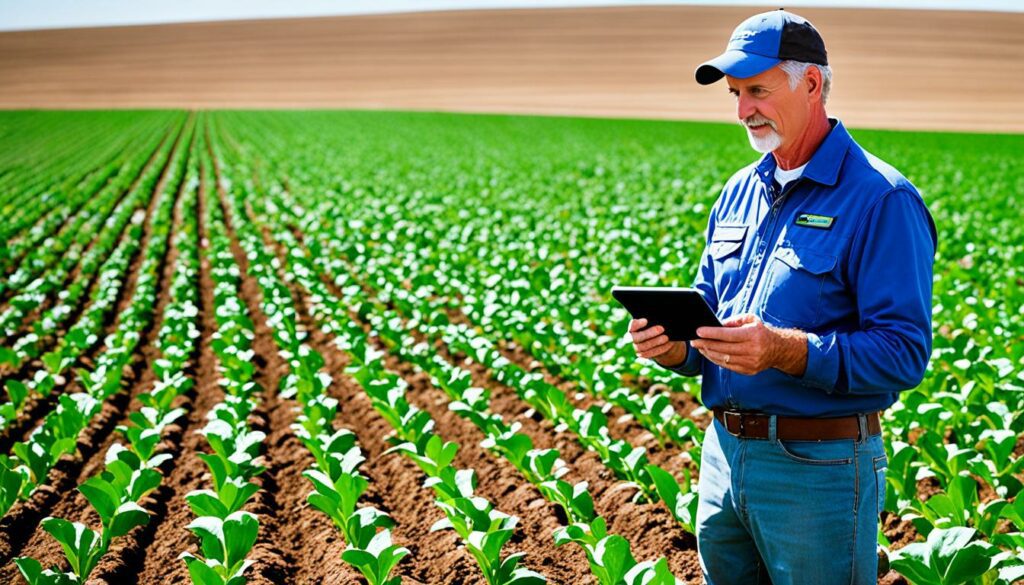
Precision tools help farmers get more crops by managing their fields better. They make detailed maps with GPS. Farmers can use these to fight pests and weeds where they are, helping crops grow stronger.
GPS plays a crucial role in keeping nature safe. It helps farmers use less chemicals by targeting where they are needed. Flying over fields, GPS-directed planes only spray areas that need chemicals. This saves the environment and creates greener farming.
Using precision agriculture tracking tools also cuts costs for farmers. They spend less on chemicals because GPS shows them exactly where to put them. Plus, GPS makes getting around the farm easier. This means less time and fuel are used, saving even more money.
In the United States, there are plans to make GPS even better for farming. This will lead to more savings in the future.
In agriculture, being efficient is key to farm sustainability. With GPS fleet management, farms save time and use labour better. This makes daily tasks smoother and more effective. GPS technology ensures equipment moves along set paths, reducing overlap and skip-overs.
The key is managing time well, and GPS fleet management helps with that. It allows farmers to track work hours accurately. This means every tractor and tool can be used to its fullest. Thanks to GPS tracking, farmers can make solid schedules. This helps in doing maintenance on time and lessening pauses. The result is better time use that boosts farm work.
GPS fleet management also helps in using labour wisely. It keeps an eye on farm tasks, so work is assigned where it’s most necessary. This approach cuts down on both fuel use and labour costs. Using GPS for planting ensures seeds go in at the perfect depth and space. This raises crop yields and reduces work needed later on.
The U.S. Department of Agriculture notes over 50% of farm lands now use GPS for planting key crops. This big use shows the value of GPS in farming today.
Also, better farming with GPS means lower greenhouse gas emissions. The EPA says smarter farming cuts down on wasted trips and uses machines better. So, farms can lessen their impact on the environment.
It’s important to train older farmers on GPS tech because most are around 57 years old. The 2022 Census of Agriculture shows this. Teaching them new tech is vital to keep farming efficient. The future looks bright with how GPS farming is making agriculture better.
Fuel is a big slice of costs in agriculture, making up 19% in 2020 for trucks. Using agricultural GPS tracking solutions helps manage these costs by watching over fuel use. It finds where fuel’s wasted, cutting expenses.
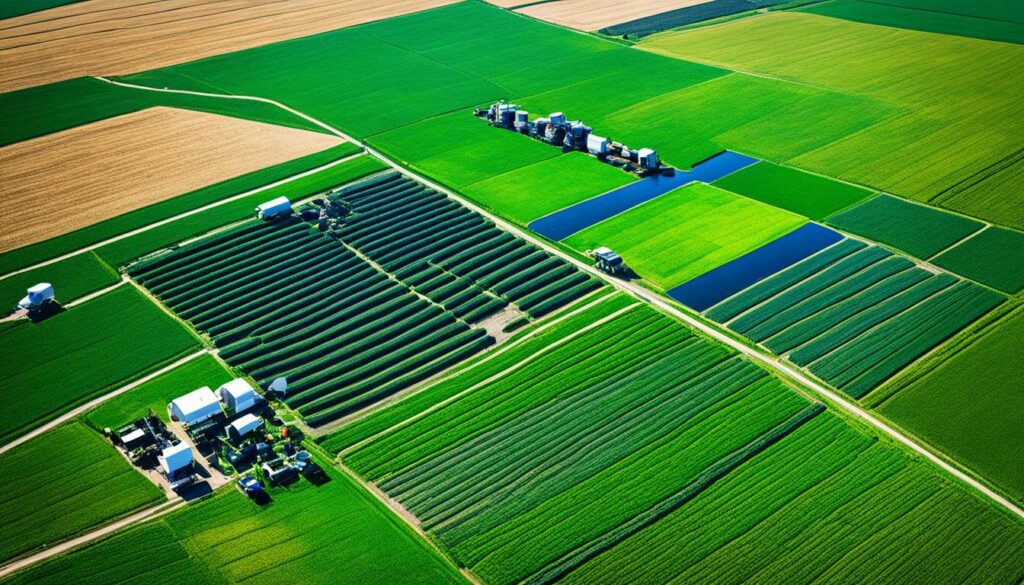
Agricultural GPS tracking solutions give farmers instant fuel use info. This shows when they use less fuel, saving money. For instance, trucks often idle, burning through cash. Cutting down on this can save a lot of wear and tear on the engine.
Saving on idling time can save more than you think. A truck idling less can save what’s like 64,000 miles of engine wear. This cuts big costs on fuel over time.
| Scenario | Fuel Cost Impact |
|---|---|
| Reduced Idling by 50% | Save up to $2,232 annually per vehicle |
| Optimized Routes | -20% Operational Fuel Reduction |
| Aggressive Driving Reduction | -20-30% Increase in Fuel Efficiency |
Agricultural GPS tracking solutions pinpoint bad driving that sucks up fuel. The University of Michigan found being aggressive can drop fuel efficiency by 20-30%. Using GPS data helps improve how drivers drive, saving fuel.
Keeping tyres right is also key. Properly inflated tyres can make a 3% fuel efficiency difference. This was proved by NHTSA.
Also, teaching drivers better driving through training programs improves fuel use. Dutch Maid’s program boosted fuel efficiency from 6.7 to 8.1-8.3 mpg. This saves a lot of money yearly per driver. So, agricultural GPS tracking solutions tailor ways to save fuel, cut costs, and help the environment.
Advanced precision agriculture tools, using GPS, are vital for today’s farms. They help me manage crops better, leading to higher yields. This tech impacts farming in many ways, from accurate planting to smart geofencing.
GPS makes planting crops precisely very important. It lets me plant seeds just right, which makes plants grow better. This method links precise planting with more crops grown, using fewer seeds, water, and fertilisers.
It helps by:
Using geofencing and landmark tracking wisely is key for good crop management. These tools help me set virtual boundaries and collect detailed landscape information. This data helps me make smarter choices for planting and taking care of the land. Geofencing also adds a layer of field security and management.
The good of geofencing is:
Adding these tools to daily farm work means better, more forward-thinking decisions. This makes farming more productive and cost-effective. GPS in farming highlights a move towards a high-tech, data-centric agriculture.
Using GPS farm equipment tracking boosts the security of farming gear. It gives farmers a way to watch their machines in real-time. This technology, like what Verizon Connect offers, lowers costs and improves work efficiency.
Fleet tracking helps quickly find machines, even in remote spots. It brings calm to farm managers. Geofencing makes sure assets are watched closely. It notes details like time in areas, when they arrive and leave, how long on the move, and when they’re idle.
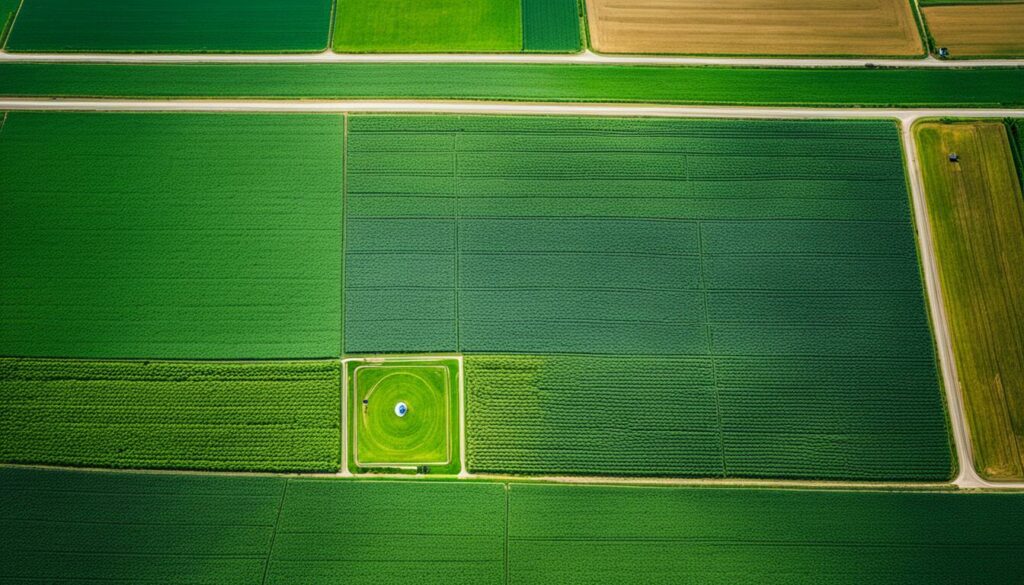
Surveillance alarms for after-hours are key in GPS farm equipment tracking. These features cut the risk of theft and speed up getting stolen items back. The National Equipment Register reported over 10,000 cases of theft in 2016. This mainly happened in Texas and other places.
With GPS, all machines like tractors and combines can be watched at all times. It helps in both theft prevention and cheaper insurance costs. This is a big help to farmers’ budgets.
Studies show that GPS and VRT improve farm work a lot. Witmer’s study proved that using GPS boosts productivity and saves on costs. For example, using GPS to vary soybean seed rates saves money and boosts yield.
But, only a small number of tractors have GPS. This leaves a lot of farm gear at risk. Getting GPS for all machines is smart and saves money in the long run.
| Feature | Benefit |
|---|---|
| Real-Time Tracking | Immediate location updates, improving recovery rates of stolen assets |
| Geofencing | Monitors equipment activity, enhancing operational management |
| After-Hours Surveillance | Reduces theft risk significantly with timely alerts |
| Fuel Efficiency Monitoring | Analyses fuel data for improved consumption patterns |
GPS technology has changed how farms are managed. It allows farmers to track vehicles and assets in real time. This helps in making the best use of resources, increasing efficiency and productivity. With GPS, farm machinery can be monitored closely. This cuts down on downtime and improves how the farm works.
Live map tracking is a key part of GPS fleet management for farms. It lets farmers see where each vehicle and piece of equipment is. This real-time information is vital for organising field work well. It ensures tasks are done on time and helps to quickly deal with any problems. This keeps the farm running smoothly.
GPS fleet management also helps farms use their vehicles better. It shows how vehicles are used and their performance. Farm managers can then assign tasks more wisely. This leads to better use of resources and lower costs. GPS technology also supports precision farming. It makes sure all equipment is fully used, boosting productivity.
Since 1948, US farm output has more than doubled, with less land and workers used. This shows the value of advanced tools like GPS. A UN report says we need 70% more food than in 2007 to feed everyone. Using GPS in farming is key to meeting these goals.
| Advantage | Description |
|---|---|
| Real-Time Tracking | Live updates on the location and status of farm equipment. |
| Enhanced Efficiency | Optimises route and task allocation for better productivity. |
| Cost Reduction | Reduces non-productive labour and lowers fuel consumption. |
| Improved Security | Enables swift recovery in case of theft and real-time alerts for unauthorised use. |
To sum up, GPS has become key in modern farm management. It boosts efficiency and makes farm work more smooth and economical. Using GPS for farm fleets is a major step towards a better, more productive future in farming.
Geofencing is key in today’s farming for better safety and work flow. It sets up virtual borders, keeping a sharp eye on machines and goods. This extra surveillance, even during night hours, cuts down on theft and misuse risks.
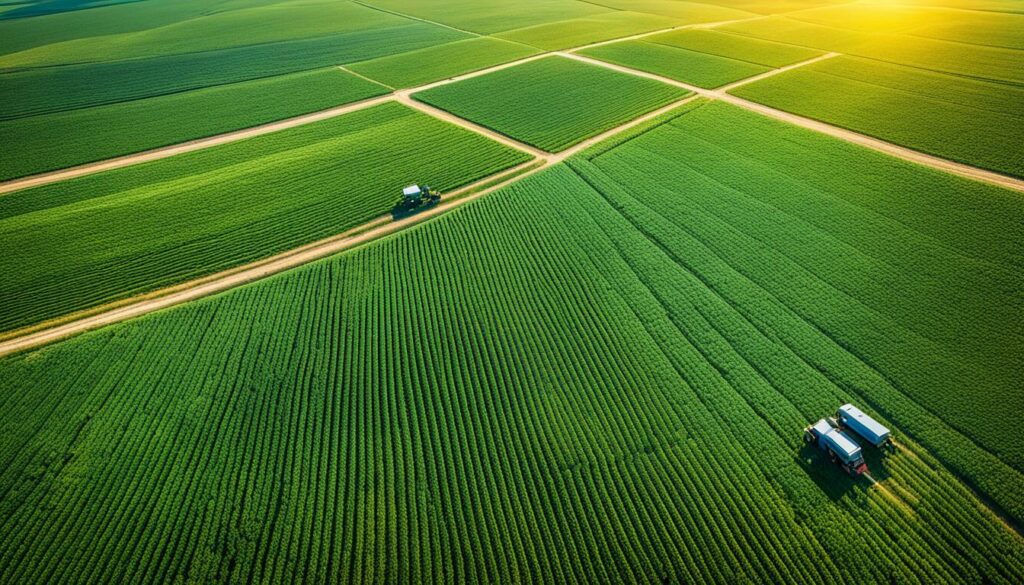
These geofences look closely at how fleet vehicles move. They note time in a spot, when they arrive and leave, and how much they sit idle. This data is a goldmine for making the most of things and boosting how workers do. Keeping tabs on engine use, where the machines go, and their thirst for fuel helps use resources better. It also brings down the cost of running things.
Fleet tracking tech plays a big role in finding machines far out, giving peace to those who own them. It stops unverified use or theft in its tracks. If a vehicle strays beyond its geofenced area, owners get a warning. This fast notice lets them act quick if needed.
Farmers who go for top-shelf solutions, like Trackhawk GPS trackers, can really keep an eye on their vehicles. This means they’re able to plan use and trips better. Using farm machinery tracking systems helps meet rules, keeps detailed records, and shores up safety. The result is a more efficient, safer farm setup.
Plus, teaching staff to drive safer through alerts brings bonus safety on the road and saves on fuel. Big names like Verizon Connect offer all they need on one spot. This includes managing fleets, watching assets, and geofencing with ease.
Looking at the real outcomes, Witmer’s Feed and Grain upped their fleet’s output and tools’ use with Verizon Connect GPS. Reports from actual fuel use for the whole fleet help save money and work better.
The joining of IoT with GPS brings amazing possibilities to *tracking farming equipment*. It opens doors to precise control and easy access in managing farm assets. Sensors and trackers help farmers produce more, save water and fertiliser, cut down on waste, and boost work.
Thanks to cellular IoT and networks like LoRaWAN®, keeping an eye on equipment has become simpler. This tech lets farmers track run hours and plan for upkeep efficiently. It’s not just about the equipment. Checking soil moisture helps crops grow better and produce more.
Water sensors keep track of tank levels and warn when they run low. This helps use water wisely. Also, temperature and crop sensors give instant updates to improve how much crop is produced.
There are many ways to stay connected globally, like Cellular and LoRaWAN®. These connections ensure tracking devices work in tough farm conditions. They are built tough to last, even in harsh weather.
Smart tools take note of how long equipment runs and suggest ways to use them better. They can also set up location-based alerts, which boost safety and how well tasks are done. These tools can keep an eye on doors, water usage, and pump status too.
Installing sensors and GPS devices is easy and can work for many needs. The systems are made to be quick and flexible, helping farmers make better choices fast.
In short, *using IoT to track farm equipment* helps farming be more efficient and make more. This move to use more data and tech in farming shows a big change. It’s about improving farming while looking out for the land and profits.
GPS technology is changing the way farmers look after their animals. It offers data on where the animals are and their health. This helps improve how farms are run and keeps the animals safe.
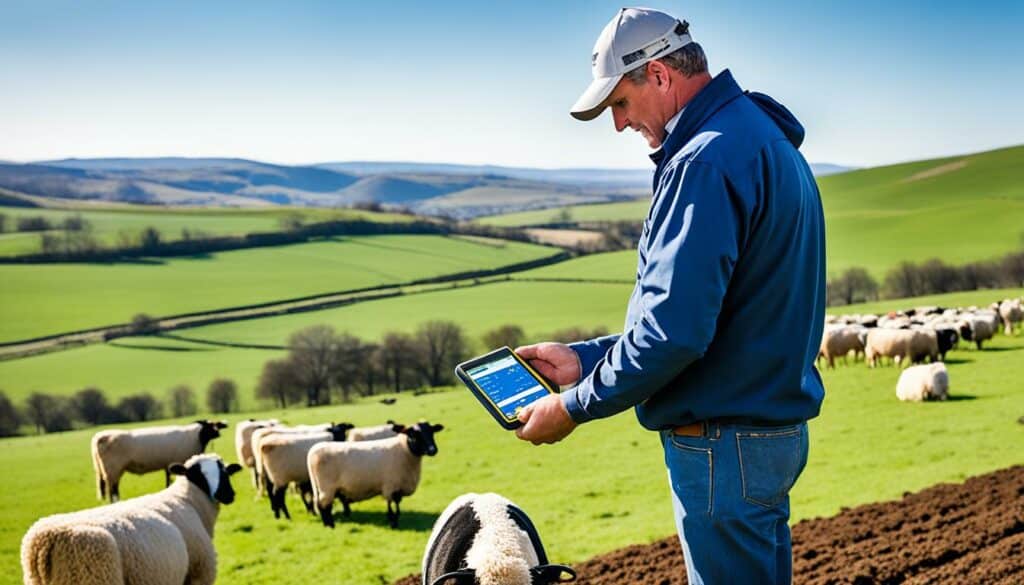
Tracking devices for livestock have features essential for farming today. They show where animals are, their past movements and speed. They also offer geofencing and alerts for when animals are not moving. This helps farmers take better care of their animals and their land.
Devices to track cows are tough and can handle bad weather. They use regular batteries and warn when the battery is low. These devices can update locations at set times or when animals move. They also let farmers set up special alerts to improve how they manage their herds.
Agri-GPS tools heighten livestock safety and output. They lower theft and loss risks. If theft happens, these devices can help find the missing animals fast.
Precision agriculture tools are changing farming. They offer custom solutions using GPS devices. These tools make many tasks easier, saving time and money. Let’s look at the types and features of these GPS devices.
There are many types of GPS trackers for farming. They vary in size and capability to fit different farming needs. For example:
Choosing the right tracking tools is important. You need features that ensure they work well and are reliable. Here are essential features to focus on:
By picking the best tracking tools, farmers can improve a lot. These tools help save money and work more efficiently. Investing in technology like this is investing in a greener, smarter way to farm.
Small farms often struggle with using resources efficiently. Luckily, new farm machinery tracking systems now offer affordable GPS tools. These help boost productivity without spending too much.
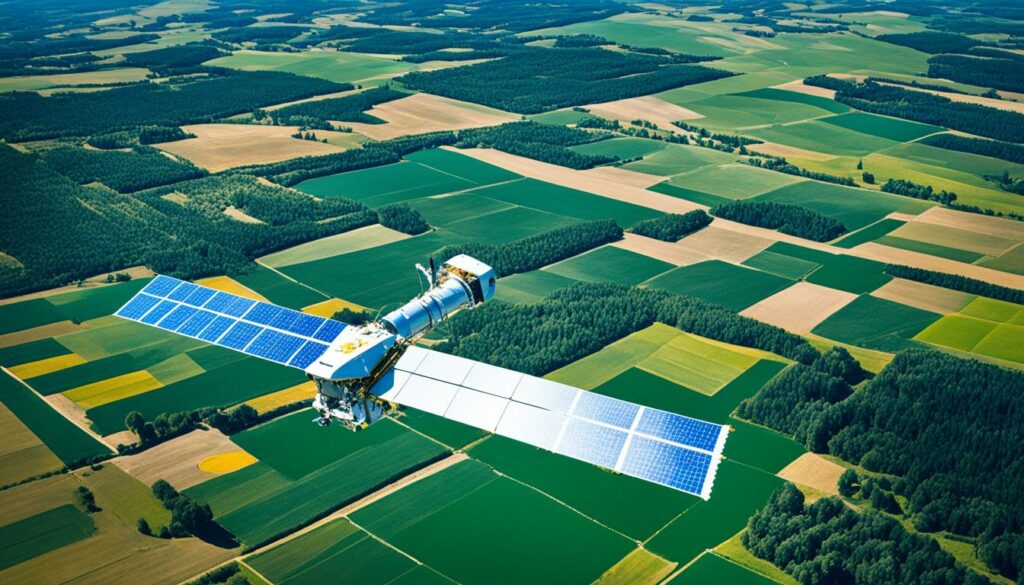
Small farms can now make use of cheap GPS trackers. For example, the LandAirSea 54 GPS tracker includes important features like InstaFence and geofence alerts. It costs much less than other GPS devices.
LandAirSea’s GPS trackers are about 80% less expensive than their rivals. They work with over 30 satellites for accurate and reliable tracking.
It’s essential for small farms to make the most of what they have. The LandAirSea Overdrive GPS tracker lasts three to four times longer than the LandAirSea 54. This means less charging and maintenance, saving time and money.
The PowerGuide manual steering system is also great. It saves about 10% on input and labour costs. Small farms can use this savings for advanced tracking technology. It gives them a good return on investment with just 10 hectares.
FieldBee is a top pick, known for its strong farmer community and many satisfied users. Their PowerSteer autosteering system ensures precise and efficient tracking on all terrains. This boosts the use of resources.
With these affordable tools, small farms can enhance crop yields and efficiency. Advanced farm machinery tracking is now accessible to farms with limited resources.
Using GPS technology has improved farm operations a lot. But, there are still hurdles like weak connections and incorrect data. These issues are big for managing farms well.
Farm areas often have poor internet, making data flows stop. This is a problem for GPS systems needing instant data for decisions. The use of satellite links and better rural internet is helping. They keep the data stream flowing smoothly, making farm work easier.
Getting correct data is crucial in farming today. Modern GPS systems are improving by offering more accurate data. This includes better receivers and correction tools to minimise mistakes. Using GPS with GIS and IoT gives farmers more precise details.
By using these new technologies, farmers can beat connectivity and data issues. This way, they can run their farms better and keep up with the modern agriculture world.
The joining of GPS with farming technologies like GIS and sensors is changing the game in agriculture. It boosts the precision and efficiency of farming. This mix helps farmers make smarter choices, improving how they manage and produce. IoT tracking for equipment plays a big role by offering instant data to manage resources and crops better.
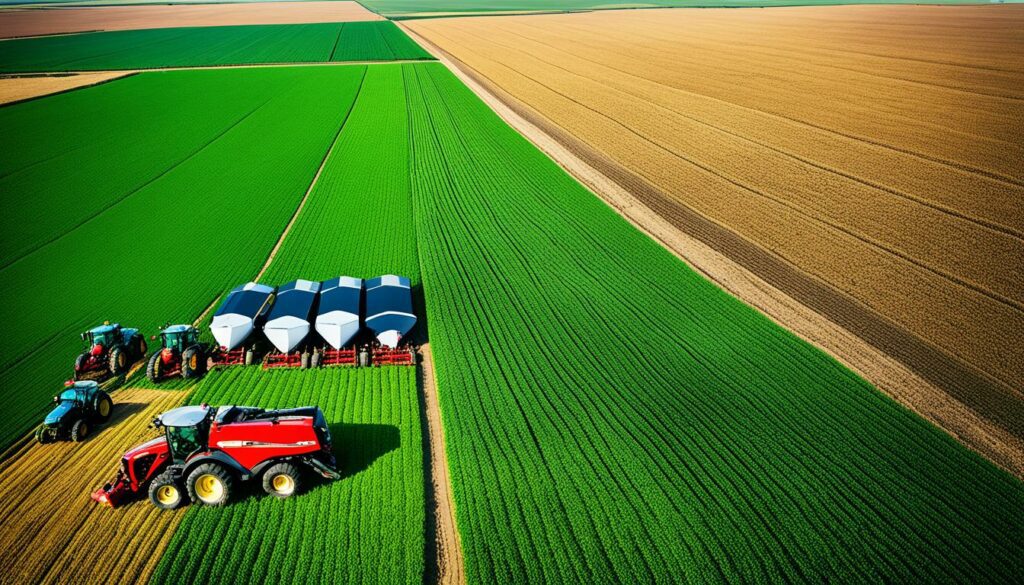
GPS and GIS working together form detailed maps and analyses of farm resources. They help outline field borders, irrigation systems, and where crops need attention. This mix makes managing land and water use far better. It sharpens the use of fertilisers and other products, cutting costs and boosting yields. This method allows for more eco-friendly farming practices while making operations smarter.
Pairing data collection sensors with GPS gives a detailed view for farming management. These sensors share key soil details, like texture, with great precision. Together with IoT for equipment, they offer data in real time. This means quick adjustments in farming methods are possible. This improved data helps in making better choices on when to plant, fertilise, and water. The end result is higher crop yields and better use of resources.
In recent years, agricultural GPS tracking has changed how farming works. It has made farming more efficient, boosted productivity, and helped to manage costs better.
John Deere leads in using GPS in their machinery. Farmers who use their GPS have noticed big improvements in planting accurately and managing resources well. Roger Easton’s team, for example, cut down on chemicals and operational costs thanks to GPS. This change not only increased their harvests but also made their farming more eco-friendly.
Smith Farms is a great example of this success from using GPS. They reduced costs and increased their crop yield by 15% with GPS. The precision of GPS was key. It helped with spot-on soil sampling and pest control, making the farm’s actions much smarter and healthier for the crops.
At Pagan Farms, using GPS to map pest hotspots made a big difference. This move made choosing the right next steps easier. This, in turn, improved their pest control efforts by giving better advice on what to do.
| Case Study | Initial Issue | GPS Solution | Results |
|---|---|---|---|
| John Deere | High chemical use | Precision planting and resource management | Reduced chemical use, cost savings, increased yields |
| Smith Farms | High operational expenses | Precise mapping for soil sampling | 15% increase in crop yield, reduced expenses |
| Pagan Farms | Pest infestations | Pest mapping via GPS | Improved pest control, optimised input recommendations |
Farming is set to change with new GPS tech trends. This tech keeps getting better and makes farming much smarter. It’s all about using precision tools to track in detail.
New GPS tools for farming look very promising. They join with drones, satellite photos, and IoT gadgets. This mix makes farm work better by giving real-time data and helping with small details.
New tools like Guardian Agriculture’s SC1 eVTOL help cover big farms quickly. And gadgets like Croptimistic Technology Inc.’s SWAT CAM make tasks like counting plants easier. This saves time and boosts how much we can do.
GPS changes how we farm, making things more efficient, productive, and green. It’s already saving fuel for tractors and lessening the need for manual labour. This means less cost, less work, and bigger crops.
There are big environmental benefits too. With GPS, we can use fertilisers and pesticides closely, cutting pollution and protecting water. Techniques like controlled traffic farming help save the soil and keep everything healthy.
| Advancements | Impact |
|---|---|
| SC1 eVTOL | Efficient aerial crop management |
| SWAT CAM | Automated plant stand counting |
| Integration of GPS with IoT | Enhanced real-time data collection |
| Targeted application of chemicals | Environmental protection |
| Controlled traffic farming | Soil conservation |
More farmers will use these precision tools soon, especially in rich countries. But poorer places are catching up fast. The future will bring even closer ties with AI and more robots on the farm. This means farming will be cleverer and healthier for our planet.
The use of agricultural GPS tracking is changing farming for the better. First created by the military in the 1970s, GPS is now key for better farming practices. It makes farming more precise by tracking equipment movements accurately.
Combining GPS with GIS is even more helpful. It allows farmers to look at soil quality, landscapes, and past yields all at once. This can be done with help from planes, drones, and satellites, making everything more efficient. Such use of data improves farming methods, like watering and using chemicals, making them more eco-friendly.
While precision farming tech can be costly, it brings big savings and becomes cheaper over time. For example, GPS apps can cut costs by avoiding field overlap. Plus, they can make farming more efficient, increasing profits. This approach, known as precision farming, is popular among farmers because it focuses on the best use of resources at the right time and place.
Choosing GPS-based farm machinery tracking is essential, not just trendy. It saves time, automates tasks like record-keeping, and offers very accurate location data. This shows how technology is key to improve agriculture, making it more efficient, sustainable, and profitable.
GPS technology in farming has evolved a lot. It began with basic maps and location finding. Now, it includes precise tools for tracking land variations and managing resources better. This helps farmers get the most out of their land.
GPS farm equipment tracking uses satellites to pinpoint locations. It’s used for mapping fields and roads, and it helps manage equipment and resources better. As a result, farming operations run more smoothly and efficiently.
GPS enables precise planting. This means seeds are put in exactly the right place. It also helps with applying fertilisers and pesticides accurately. These factors combine to boost crop health and yield.
GPS makes sure chemicals and resources are used accurately. This prevents pollution and waste. By doing this, it helps keep our environment clean and healthy.
By making sure farmers use resources wisely, GPS cuts down on waste. This leads to lower costs. Essentially, it saves farmers money by making their operations more efficient.
GPS helps farmers manage their time and work better. It keeps an eye on how equipment is used, which helps plan maintenance and work schedules. This boosts the overall productivity of the farm.
GPS tracks how much fuel is used and where improvements can be made. This data helps save money and is good for the environment.
By planting seeds exactly where they’re needed, GPS ensures crops grow evenly. It also means resources are used more efficiently. This leads to better-organised farms and a higher chance of a good crop.
Geofencing is like putting a virtual fence around a farm or area. It helps manage equipment and keep the farm secure. It also gives insights into how well the farm is running.
Combining IoT with GPS lets farmers keep an eye on their equipment in real time. It provides important data on how the equipment is doing and where it is. This information improves how efficiently the farm runs and the decisions that are made.
GPS gives farmers up-to-date information on where their animals are and how they’re doing. This helps take better care of the animals and the land they feed on. So, it boosts the farm’s productivity and the wellbeing of its livestock.
The best GPS devices are tough, accurate, and give lots of useful data. They should also work well with other technology you use. With these features, they help you make the best decisions for your farm.
Yes, there are GPS tracking options that won’t break the bank for small farms. These options can actually end up saving you money by making your farm more productive and efficient. There’s no need for a big initial investment.
New technology and better integration are tackling issues with connection. They make sure the data flow is always on and accurate. Using multiple networks and backups helps keep everything working smoothly.
GPS can work together with systems like GIS and sensors. This makes a powerful network that gives you better, more detailed information. With this setup, you can make smart, informed decisions for your farm.
Studies have shown that using GPS for farming increases productivity and security. It also helps in managing the farm based on data, making everything more efficient. Real examples prove that GPS is a valuable tool for modern agriculture.
In the future, GPS in farming will get even better and more accurate. New features and signals are coming. These changes will make farming more productive and better for the environment.